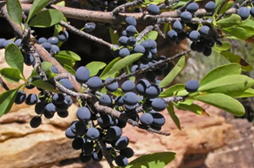By Karen Vanderwall
This month we are featuring the Colorado native: New Mexican Privet. Upon first learning of this shrub, I envisioned a privet – a dense, tough shrub trimmed into a hedge for a privacy screen. Well as in many cases, and this one is a good example, a plant’s common name can be deceptive. Although it does have a dense growth habit, the New Mexican Privet isn’t a privet at all; it is in the Olive Family. The common names of Forestiera pubescens – such as New Mexico Olive, Desert Olive, Stretchberry, Elbow Bush and Texas Forsythia – do tell a lot about this fantastic shrub but there is more to the story!

The New Mexico Privet is a deciduous small tree or large upright shrub growing from 8 feet to 12 feet high and 6 feet to 8 feet wide. It can be found from New Mexico to Southern Colorado and up into Utah at between 4200 and 7300 feet in elevation.
Forestiera has light green leaves that turn yellow in the fall. It produces small yellow non-showy flowers in the spring that resemble forsythia, resulting in the female plants producing blue-black berries that form clusters. The berries are actually drupes, which means they are fruits that have a fleshy outer part surrounding a central hard pit that contains the seed; hence the ‘olive’ in its other common names. The bark is an off-white or pale gray, so the branches, which grow in an ‘elbow’ branching pattern, can add to winter interest.
The New Mexican Privet is very drought tolerant so a good choice for Colorado low-water gardens. It grows in sun or part shade, in USDA cold hardiness zones 4-9 and is hardy up to 7500 feet in elevation.
In order for the female shrub to produce fruit, a male shrub must be planted. The berries, along with being showy and attractive, are loved by birds.

Forestiera can be left to grow in its natural shrub shape or it can be trimmed into a multi-stem tree by pruning out lower twigs to be able to display the off-white bark.
The New Mexican Privet is a win win for gardeners and wildlife. For the gardener, it covers so many bases. It is fast growing, very drought tolerant and cold hardy. It is also a shrub that performs during all four seasons. Although the yellow flowers are small, they bloom early to late spring when gardeners are longing for hints of green and blossoms, and it flowers before the leaves emerge. Come fall the leaves glow, turning a bright yellow, which is particularly stunning with the contrast of the dark blue berries. If the gardener chooses to do some trimming, the white bark of the lower branches are a nice contrast to a darker background in the winter months.
For wildlife, Forestiera flowers are a source of nectar for butterflies, bees and other insects. And as they bloom early, they provide nectar for small, early spring butterflies like the hairstreaks. The growth of the New Mexico Privet is relatively dense providing nesting sites and shelter for birds and other small animals. The blue-black berries produced by the female plants are a good food source for birds.
Another great attribute of tough shrubs like the New Mexico Privet, is that it can grow in various habitats, which makes it a good choice for garden designing and to create diverse wildlife habitats.
The New Mexican Privet, New Mexico Olive, Elbow Bush, Texas Forsythia or Forestiera pubescens is an excellent choice for any native Colorado landscape.
